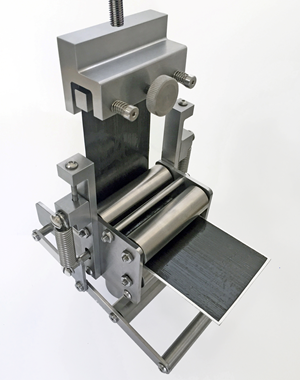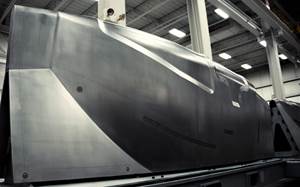Future multifunctional structures: Composites needed
Barton Bennett (Odyssian Technology, South Bend, Ind.) discusses multifunctional systems that will soon integrate composite structures with sensors, mechanisms and subsystems.
Multifunctional structure technology encompasses a vast array of technologies, including structural health monitoring, smart structures, morphing structures, adaptive structures, self-healing structures and a multitude of related technologies. All of these offer the common benefit of increasing system-level capability and efficiency by integrating structure with sensors, mechanisms and subsystems. Ongoing technological advances in miniaturization will stimulate a drive toward even greater levels of integration. Examples of miniaturization technologies include microelectromechanical systems (MEMS), nanocomposites and materials, micro-miniaturization of electronics, thin films, embedded passive electronics and solid state actuating materials.
The U.S. military and the National Aeronautics and Space Admin. (NASA) have been, and continue to be, the primary force behind the development of multifunctional structure technologies, and have long recognized their benefits. Multifunctional composite structure was demonstrated on NASA’s New Millennium Program Deep Space 1 spacecraft, which was built by Lockheed Martin Astronautics (Denver, Colo.). Under this program, the multifunctional electronic structure, which included conventional flex circuitry, demonstrated an estimated 50 to 80 percent savings in mass and volume. Other platforms have demonstrated the benefits of multifunctional structure, including NASA’s EOS-1, the Boeing Co.’s (Chicago, Ill.) Delta IV ELV launch vehicle and the Global Hawk unmanned aerial system. Most of this work has focused on embedding lightweight circuits in composite structures to achieve mass reduction of more than 50 percent.
Structural health monitoring in future aircraft will allow for rapid damage detection, repair and redeployment. Conformal load-bearing antenna aerostructures will allow for improved detection and communication while maintaining desired stealth and aerodynamic performance. Looking forward, embedded low-profile actuators and modulus-changing material systems will allow for adaptive space and air vehicle structures that respond to changing environmental conditions, thus improving aerodynamic control and system survivability. Highly integrated or embedded electronics will reduce the weight and volume of future high-performance systems by eliminating support chassis, avionic/electronic racks, enclosures, brackets, clips and insulation/isolation materials. Reduced volume, in turn, will permit either a lower overall system size or an increase in available payload volume. Cost reduction will be achieved by eliminating the cost of design, production planning and control, and manufacturing associated with each part that is no longer required.
R&D is already underway on many fronts that will contribute to the realization of highly integrated and embedded subsystems for future space and aircraft structures. Enabling technologies that are required include new circuit design architectures with distributed redundancy, fast-acting thin-film switching, and structural gradient and tailored materials for force load control. Thin- and thick-film multilayer power and signal networks likely will be deeply embedded within a composite airframe structure near the neutral axis to minimize shear loads. The networks will transfer signal and power through the use of structural vias (z-axis conductors) that are designed to handle shear loads while minimizing degradation of in-plane strength in the composite structure. Thermal management of active, heat-generating components will be achieved through larger area circuitry and coupling to thermally conductive structural elements. High-speed communication will be realized by improving the performance of intrinsically conductive polymers and engineered electrically conductive polymer materials. Other areas of required research include neural network science, reconfigurable or self-healing structural power/communication networks, and high-performance actuating and morphing material systems and circuit devices that support adaptive structures and flight control. As these structurally integrated signal and power networks develop, they will offer great performance advantages and undoubtedly will be found in future spacecraft and high-performance aircraft, working together with composite structures.
For consumer products, miniaturization of electronic and mechanical components will help achieve smaller and smarter products. Integrating these miniaturized components into structures and housings will allow even greater weight/volume reductions with increased sophistication and functional capability. For example, some automakers have begun to embed sensors into automobile bumpers and side panels, which can enable the relay of collision data to emergency medical personnel. And, there are countless other applications: Sporting goods now in development will use multifunctional structures to improve athletic performance — something already possible in composite snow skis and tennis rackets that have embedded piezoelectric materials for vibration control.
To reap the full benefit of this high pay-off technology trend, research must continue in multiple areas to develop and demonstrate adequate structural, thermal, signal-processing and networking performance. The close collaboration of those with expertise in composite materials will be essential to success.
Related Content
Composite prepreg tack testing
A recently standardized prepreg tack test method has been developed for use in material selection, quality control and adjusting cure process parameters for automated layup processes.
Read MoreNine factors to consider when designing composites cure tooling
Gary Bond discusses the common pitfalls and compromises when designing good cure tooling and their holistic significance for a robust composite production process.
Read MoreMulti-material steel/composite leaf spring targets lightweight, high-volume applications
Rassini International was challenged by Ford Motor Co. to take weight out of the F-150 pickup truck. Rassini responded with a multi-material steel/composite hybrid leaf spring system that can be manufactured at high volumes.
Read MoreASCEND program update: Designing next-gen, high-rate auto and aerospace composites
GKN Aerospace, McLaren Automotive and U.K.-based partners share goals and progress aiming at high-rate, Industry 4.0-enabled, sustainable materials and processes.
Read MoreRead Next
From the CW Archives: The tale of the thermoplastic cryotank
In 2006, guest columnist Bob Hartunian related the story of his efforts two decades prior, while at McDonnell Douglas, to develop a thermoplastic composite crytank for hydrogen storage. He learned a lot of lessons.
Read MoreCW’s 2024 Top Shops survey offers new approach to benchmarking
Respondents that complete the survey by April 30, 2024, have the chance to be recognized as an honoree.
Read MoreComposites end markets: Energy (2024)
Composites are used widely in oil/gas, wind and other renewable energy applications. Despite market challenges, growth potential and innovation for composites continue.
Read More






















